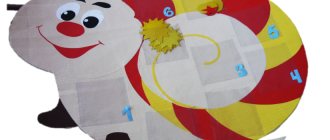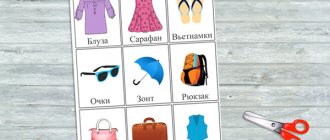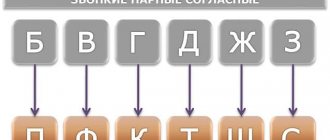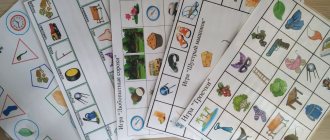Author's didactic game "Gromozeka"
Goal: with the help of a multifunctional author's game, increase the effectiveness of speech therapy, create interest in classes on the formation of the grammatical structure of speech, and create positive motivation in children.
Tasks:
- formation and consolidation of the skill of forming diminutive suffixes;
- consolidation of the use of prepositions “ON”, “C”, “UNDER”, “ABOUT”, “IN”, “FROM”, “FOR”, “BEFORE”, etc.;
- expansion of the active dictionary;
- automation of sounds “R” and “L” in words;
- differentiation of sounds “R” and “L”;
- formation and consolidation of the skill of agreeing nouns with numerals;
- formation and consolidation of the skill of agreeing pronouns with nouns in number and gender;
- practicing quantitative and ordinal recalculation of items;
- development of visual perception and memory;
- formation of spatial representations and orientation on a sheet of paper;
- formation and consolidation of the skill of agreeing nouns with adjectives;
- practicing the skill of using plural nouns;
- development of coherent speech, composing sentences;
The game is multifunctional, its use depends on the tasks of the speech therapist in a specific lesson. It can be used in frontal classes, in individual and subgroup work with children.
Equipment: two posters depicting “Gromozeki” and his room, small cards depicting the same objects that are in the room.
Preliminary work : watching the cartoon “The Secret of the Third Planet” with children, discussing the hero “Gromozeki” (Explaining to children that the hero is fictional, non-existent, so that children learn that in real life there are no persons with so many eyes, ears, etc. .).
Example possible games:
1. Game “Recounting Items”
Goal: formation and consolidation of the skill of agreeing nouns with numerals; working out quantitative calculations,
expansion of the dictionary on the topic “Man. Parts of the body", the formation of spatial representations and orientation on a sheet of paper.
Progress: Guys, let's count the body parts of "Gromozeki" and the objects in his room.
(One nose, two noses, three noses....
One tree, two trees, three trees... etc.)
2. Game “Where is what?”
Goal: to consolidate the use of prepositions “ON”, “C”, “UNDER”, “ABOUT”, “IN”, “FROM”, “FOR”, “BEFORE”, etc.;
Move: Guys, let's see how Gromozeka arranged the furniture and objects in his room (What is in the upper left corner?, Where is the ball?, What is higher - the ball or the table?, Where is that ball? Where is the ring? Where is Gromozeka from? will he take the ring?, etc.
3. Game "Big Small"
Goal: formation and consolidation of the skill of forming diminutive suffixes, development of visual perception, practicing the skill of using nouns in the plural.
Progress: Guys, Gromozeka has large objects at home for him and small ones for his children. Let's try to find them.
(Gromozeka has a table, and his child? (table) And his children? (tables), etc.)
4. Game "Greedy"
Goal: to develop and consolidate the skill of agreeing pronouns with nouns in number and gender.
Move: Children, let's play "Greedy" with Gromozeka
(Gromozeka – whose ring is this? The child is my ring! Gromozeka – whose pencil is this? The child is my pencil, etc.)
5. Game "Detectives"
Goal: automation of the sounds “R” “L” in words, differentiation of the sounds “R” and “L” in words, development of visual perception and attention, development of the skill of sound analysis and synthesis, formation and consolidation of the skill of agreeing nouns with numerals.
Progress: Find objects whose names contain the sound “L”. Count them. Determine the place of the sound L in the word. First count the words whose names contain the sound “R”, then “L”.
(Spoon. One spoon, two spoons, three spoons....
One fork, two forks...; one eye, etc.)
6. Game “Which one?” Which? Which? Which?"
Goal: development of coherent speech, composing sentences; formation and consolidation of the skill of agreeing nouns with adjectives.
Hod: Tell me what objects you see in Gromozeka’s room? Describe them. Make sentences of three words; of four words; with a small word (preposition) “ON”, etc.
7. Game: “What has changed?”
Goal: development of visual perception and memory, development of coherent speech, composing sentences, consolidating the use of prepositions “ON”, “C”, “UNDER”, “ABOUT”, “IN”, “FROM”, “FOR”, “BEFORE” and etc.;
Progress: Children carefully look at the pictures, then the speech therapist removes them and lays out a fragment from small cards, but swapping something in places. The task of the children is to remember what is wrong and to compose a sentence in which to name the correct place of the object, possibly using different prepositions.
(The speech therapist puts a picture of a table, and places a rose on the table. The child must construct a sentence - “There was a ring on the table, not a rose,” etc.)
8. Game "Compare"
Goal: development of coherent speech, composing sentences with opposition, formation and consolidation of the skill of agreeing nouns with numerals, development of visual attention.
Move: Guys, let's compare a person and "Gromozeka" and construct sentences with the little word "A". (A person has one nose, and a Gromozeka has five noses, a person has five fingers, and a Gromozeka has four fingers, etc.)
Not all concepts, categories and topics that can be worked on with children using this manual are described here.
Your imagination will help you apply it in many other ways. For the full text of the material, the author's didactic game "Gromozeka", see the downloadable file
. The page contains a fragment.
| Author: Olga Leonidovna Bukhovtsova → Publisher 10/16/2015 0 4921 361 | Comment |
Thank you for your mark. If you want your name to be known to the author, log in to the site as a user and click Thank you again. Your name will appear on this page.
Login | Registration
Have an opinion? Leave a comment
A collection of speech therapy aids
Visual materials for the speech therapy center
Speech therapist teacher: Makeeva V.V.
Didactic game “Big Laundry”
In this game we erase unnecessary letters in words. Children take the thing and read the encrypted word on the back: you need to read only capital letters, not counting capital letters. For example: DyOrM. We read only capital letters: HOME. After reading, we place this item in a washing machine that matches the color.
Develops: visual perception, logical thinking
Game for developing speech breathing “Football”
Two children are trying to blow cotton wool or a tennis ball into the opponent's goal
Math house
Can be used to solve examples, study number series, . We play the games “Find the neighbors”, “Rank in ascending order”, “Rank in descending order.”
Hungry fruits.
Hungry animals. (for the development of speech breathing)
We blow cotton wool into the “mouth” of animals and fruits
Didactic game "Greedy"
(for studying gender and numbers)
Lapbup on the theme “Wild and Domestic Animals”
Computer speech therapy games
Tactile tracks
Each track is a path, walking along which the child pronounces specified sounds. Each press produces a sound.
Didactic game “Small Birds”
This game features 4 houses with different windows. The child needs to choose the right window for each house.
Cubes (tetrapack)
Mosaic
Develops attention, perseverance, observation, fine motor skills.
"Beans"
We lay out the shapes with beans along the contour and without the contour. Develops fine motor skills.
Game “Sounding barrels”
(for the development of auditory perception
) There are 6 barrels in the container: 3 pairs of 2 identical ones. The teacher keeps one group for himself, and gives the other to the child. The child must guess a similar barrel by sound.
"Pantry"
Inside the boxes are beads with different numbers (from 1 to 10). You need to correlate the number of beads with the number that indicates this quantity. And then we put these beads into a box with this number.
On the reverse side are the images from which we need to assemble the puzzle.
Magic chest
Inside the chest, various objects are hidden among colorful pasta. Children, without looking, put their hand into the chest and by touch try to guess what got into their hand. At the same time, children describe what this object feels like to the touch.
Game "Kite"
On the reverse side it is written in what order, in what quantity and in what color you need to attach paper clips to the kite.
With the help of such a device, the child determines the position of the sound in the word.
“Language Maker”
Difficult to pronounce combinations of sounds are written on the cards.
Lacing
We use lacing through buttons and such balls. Develops fine motor skills.
Games with clothespins and paper clips.
Please draw the rays of the sun, the needles of a hedgehog. Develops fine motor skills and color perception.
Thank you for your attention!!! Creative success!







